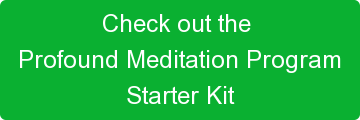Tips for Beginners: Getting Started with Brain Entrainment Meditation
 To those of you who are just starting out with the Profound Meditation Program, I want to say that I’m very excited for you, because the changes, shifts, and transformation that can happen are really remarkable. Here, I’d like to give you a few tips, and hopefully some really useful information, to get you on the path. I call it the “evolutionary fast lane”—where you’re doing your work, dealing with your stuff, improving the function of your brain, deepening your spiritual connection, and releasing your past traumas, old stories, and old conditioning.
To those of you who are just starting out with the Profound Meditation Program, I want to say that I’m very excited for you, because the changes, shifts, and transformation that can happen are really remarkable. Here, I’d like to give you a few tips, and hopefully some really useful information, to get you on the path. I call it the “evolutionary fast lane”—where you’re doing your work, dealing with your stuff, improving the function of your brain, deepening your spiritual connection, and releasing your past traumas, old stories, and old conditioning.
Tip # 1: Work up to 1 hour a day
What I recommend is to work up to doing brain entrainment meditation for an hour a day. You say, “An hour a day? That’s a lot.” Well, yes, it is, but the benefits are so great—so transformative, so inspiring, so real—why wouldn’t you want to? You have to prioritize your life!
Long-time meditators can go with an hour a day starting out. One great thing about this technology is that it meets you wherever you’re at, so if you have lots of experience with meditation, the Profound Meditation Program will pick up the progression of deepening your meditation practice right from where you’re already at. It’s often the advanced meditators who feel the power of this technology right away, because they are already sensitive to their interior spaces.
For those of us who have never done an interior practice, brain entrainment meditation will bring us into a domain that we don’t have a lot of experience in, and it’s a good idea to move into this new realm slowly and respectfully. Some of us may also be sitting on a lot of trauma, or suffering from depression, and perhaps PTSD, and need to ease into this stuff gently, because sometimes it can be really overwhelming. This technology does resurface trauma from the past, and that can be scary; it’s also wonderful, because this is how we heal. So here follows a good way to ease into the practice for beginners. After that, I will include more tips for sensitive people who may need to ease into the program even more gently.

Tip # 2: A good way to ease into the practice
Here’s a pattern that has been very successful for us:
- Start off with just 20 minutes in the morning, using track 1 of Tier 1 of the Profound Meditation Program for three days.
- On the fourth day, listen to Release track #1 for 20 minutes.
- Then, for the next cycle of 3 days PMP, one day Release, listen to track 2 of the first tier of PMP for 20 minutes each day, and on the fourth day, listen to Release track #2.
- On the third cycle, move up to track 3 of the first tier of PMP, followed by #3 Release.
- Once you finish with this cycle, you can try doing 40 minutes a day—listening to PMP Tier 1, tracks 1 and 2, for three days, and then on the fourth day, listening to Release tracks #1 and #2.
- In this manner, you can work up to the complete hour of PMP Tier 1, and all three Release tracks on the fourth day.
- Once you are listening to PMP Tier 1 for an hour a day, when you feel ready, you can move on to PMP Tier 2, and then PMP Tier 3, still listening to an hour of Release every fourth day.
- Finally, after you have listened to PMP Tier 3 for some time, when you feel ready, just go back to Tier 1.
One very interesting aspect of the Profound Meditation Program is that because of the complexity of this technology, and the way in which Eric Thompson (PMP creator) has put PMP together, the effects of the program are cumulative. So, after you’ve gone through PMP Tiers 1, 2, and 3, and you’re back at Tier 1 again, you’ll find that your experience of Tier 1 is different from when you first started. This is because the brain will start to function at higher and higher levels. Just like your experience of your first Beatles’ song when you were five years old is different from when you hear the same Beatles’ song when you’re 45, you will experience each tier differently over time, because there has been a lot of change and development in the meantime.
Although we’re very similar in our genetic structures, our brains, and our nervous systems, within those similarities, there’s also a lot of diversity. For those of us who are very sensitive, and who react quite strongly to stimuli, here are some other ways to start up our brain entrainment meditation practice.
Tip #3: Alternative ways to ease into practice for sensitive people
- Listen only to the Release tracks to begin with. Start with 20 minutes a day, work up to 40 minutes, and then the full hour when you feel ready. Gradually work into the practice program outlined above.
- For those who find even the Release tracks over-stimulating, you canturn the volume down as a means of managing the level of stimulation you are receiving.
- Another alternative is to use Audio Serenity, which is designed specifically for people dealing with anxiety. You could work with this alone for some time and then eventually progress to the Profound Meditation Program.
- Finally, if it all starts to feel like too much, you can just back off of the practice altogether for two or three days. If stuff starts coming up that you really can’t integrate, back off of the practice and let things reestablish themselves. Then try again. If you run into some very hard stuff, feel free to contact me personally, and perhaps I can help out.
___________________________________________________________________________
Adapted from iAwake Technologies’ free, weekly teleconference call on May 29, 2013.
Join our weekly calls!
To receive information on how to join the weekly iAwake coaching calls that John leads, sign up for the free meditation download and you’ll be put on the email list. You can also access the phone-in information on our Teleseminar page.
___________________________________________________________________________

John Dupuy is the CEO of iAwake Technologies and the founder of Integral Recovery, a holistic addiction treatment approach inspired by Ken Wilber’s Integral Model. He is also the author of Integral Recovery: A Revolutionary Approach to Alcoholism and Addiction, recently published by SUNY Press. As a pioneer in the use of brainwave entrainment in therapy and personal development, John has dedicated his life to helping others deepen their spiritual practice and transform their lives.
___________________________________________________________________________
Leave your comments below
1 Comments
Leave a Comment
You must be logged in to post a comment.


~I love what you all are doing here!!
…Healing & lifting to say the least!
Thank You!
-Dan